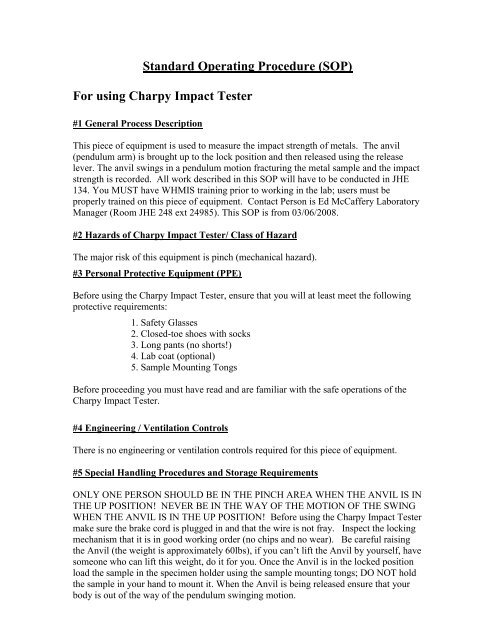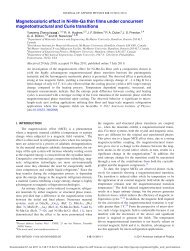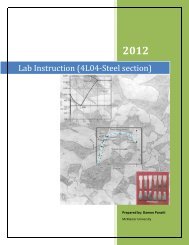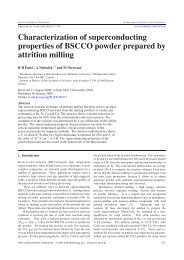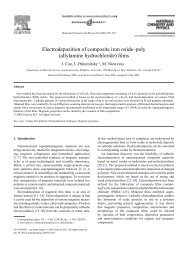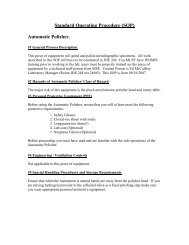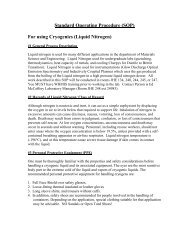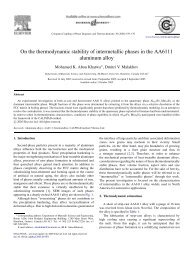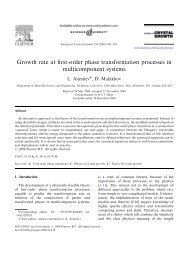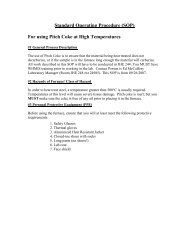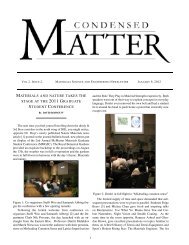Standard Operating Procedure (SOP) - McMaster Department of ...
Standard Operating Procedure (SOP) - McMaster Department of ...
Standard Operating Procedure (SOP) - McMaster Department of ...
You also want an ePaper? Increase the reach of your titles
YUMPU automatically turns print PDFs into web optimized ePapers that Google loves.
<strong>Standard</strong> <strong>Operating</strong> <strong>Procedure</strong> (<strong>SOP</strong>)<br />
For using Charpy Impact Tester<br />
#1 General Process Description<br />
This piece <strong>of</strong> equipment is used to measure the impact strength <strong>of</strong> metals. The anvil<br />
(pendulum arm) is brought up to the lock position and then released using the release<br />
lever. The anvil swings in a pendulum motion fracturing the metal sample and the impact<br />
strength is recorded. All work described in this <strong>SOP</strong> will have to be conducted in JHE<br />
134. You MUST have WHMIS training prior to working in the lab; users must be<br />
properly trained on this piece <strong>of</strong> equipment. Contact Person is Ed McCaffery Laboratory<br />
Manager (Room JHE 248 ext 24985). This <strong>SOP</strong> is from 03/06/2008.<br />
#2 Hazards <strong>of</strong> Charpy Impact Tester/ Class <strong>of</strong> Hazard<br />
The major risk <strong>of</strong> this equipment is pinch (mechanical hazard).<br />
#3 Personal Protective Equipment (PPE)<br />
Before using the Charpy Impact Tester, ensure that you will at least meet the following<br />
protective requirements:<br />
1. Safety Glasses<br />
2. Closed-toe shoes with socks<br />
3. Long pants (no shorts!)<br />
4. Lab coat (optional)<br />
5. Sample Mounting Tongs<br />
Before proceeding you must have read and are familiar with the safe operations <strong>of</strong> the<br />
Charpy Impact Tester.<br />
#4 Engineering / Ventilation Controls<br />
There is no engineering or ventilation controls required for this piece <strong>of</strong> equipment.<br />
#5 Special Handling <strong>Procedure</strong>s and Storage Requirements<br />
ONLY ONE PERSON SHOULD BE IN THE PINCH AREA WHEN THE ANVIL IS IN<br />
THE UP POSITION! NEVER BE IN THE WAY OF THE MOTION OF THE SWING<br />
WHEN THE ANVIL IS IN THE UP POSITION! Before using the Charpy Impact Tester<br />
make sure the brake cord is plugged in and that the wire is not fray. Inspect the locking<br />
mechanism that it is in good working order (no chips and no wear). Be careful raising<br />
the Anvil (the weight is approximately 60lbs), if you can’t lift the Anvil by yourself, have<br />
someone who can lift this weight, do it for you. Once the Anvil is in the locked position<br />
load the sample in the specimen holder using the sample mounting tongs; DO NOT hold<br />
the sample in your hand to mount it. When the Anvil is being released ensure that your<br />
body is out <strong>of</strong> the way <strong>of</strong> the pendulum swinging motion.
<strong>SOP</strong> –Charpy Impact Tester.<br />
#6 Accident <strong>Procedure</strong>s<br />
If you are injured using this piece <strong>of</strong> equipment; depending on the severity <strong>of</strong> the<br />
injury either go to the First Aid station (JHE 140) for first aid and fill out an<br />
incident report or if the injury is severe call 88 and receive medical attention<br />
immediately.<br />
If an injury does occurs, make sure the area is quarantined <strong>of</strong>f, do not clean the area if an<br />
accident occurs, the emergency response team must assess the accident scene to assess<br />
what occurred, leave the room and call 88 immediately, then EOHSS Ext 23314 and Ed<br />
McCaffery Ext 24895.<br />
#7 Waste Disposal<br />
Not Applicable<br />
#8 Training requirements<br />
Prior to entering and working in the laboratory, you must have completed the EOHSS<br />
WHMIS training. You will have to retain training documentation for at least one year.<br />
Any person conducting work in JHE 134 using this <strong>SOP</strong> must receive training on the<br />
contents <strong>of</strong> this <strong>SOP</strong>.<br />
#9 Approval Required<br />
All research staff, students, and Graduate students must be trained prior to starting work<br />
with the Charpy Impact Tester. If working after hours you have to ask for approval from<br />
your Supervisor and the Person In-charge, Laboratory Manager Ed McCaffery.<br />
#10 Decontamination<br />
Clean the area <strong>of</strong> any fractured samples and make sure the Anvil is not moving or is in<br />
the lock position before leaving the area.<br />
#11 Designated Area<br />
Upon leaving a designated work area, remove any personal protective equipment worn<br />
and wash hands. After each use (or day), wipe down the immediate work area. At the end<br />
<strong>of</strong> each project, thoroughly decontaminate the designated area before resuming normal<br />
laboratory work in the area.
<strong>SOP</strong> – Charpy Impact Tester<br />
#12 Precise Process Description<br />
1. Inspect the latch on the locking mechanism; ensure that it has no chips or that<br />
it is worn.<br />
2. Test the electric brake is working (nudge the pendulum “move it a few inches”<br />
and press the brake button to ensure that the magnetic brake is working.<br />
3. Inspect the electrical cord for the magnetic brake make sure it is plugged in<br />
correctly and that it is not frayed.<br />
4. Practice handling the specimen with the Sample mounting Tongs.<br />
5. It is essential that you wear safety glasses. You must wear closed toe shoes<br />
and long pants.<br />
6. Lift the Anvil (remember lifting with your legs NOT your back) until it is<br />
locked into position. If you are not strong enough to lift the Anvil, find<br />
someone who can, remember ONLY ONE PERSON MAY BE IN THE<br />
PINCH AREA WHEN THE ANVIL IS IN THE UP POSITION.<br />
7. Load the sample into the sample holder (Notch facing the Wall) using the<br />
Sample Mounting Tongs. Slide the load indicator to the maximum load (far<br />
left <strong>of</strong> the scale).<br />
8. Once the sample is in the holder; stand outside the gated area (Make sure no<br />
one including yourself is in the area <strong>of</strong> the pendulum), and release the Anvil<br />
by quickly lifting the release bar. If your arm cannot reach the release bar<br />
when standing outside the gated area use the extension bar.<br />
9. Once the specimen is fractured; press the brake button and hold it until the<br />
pendulum stops moving.<br />
10. It is now safe to enter the pinch area, collect the fractured specimen, and<br />
record the force required to fracture the specimen.
<strong>SOP</strong> – Charpy Impact Tester<br />
Laboratory Accident Response <strong>Procedure</strong>s<br />
Health Threatening Situation - In the event <strong>of</strong> an imminent or actual health-threatening<br />
emergency (threatening local or public health, safety, or welfare; or the environment<br />
outside the immediate area):<br />
1) CALL 88 FOR THE EMERGENCY RESPONSE<br />
REMAIN IN THE AREA TO ADVISE RESPONDERS IF YOU CAN.<br />
2) ACTIVATE LOCAL ALARM SYSTEMS IF REQUIRED) Once personal safety<br />
is established, call EOHSS at Ext 24352 and proceed with local notifications,<br />
below.<br />
Health Threatening Situation – In the event <strong>of</strong> a major injury:<br />
1) Notify <strong>McMaster</strong> Responders: Call 88 (24 hours/day, 7 days/week), then<br />
2) Provide local notifications:<br />
Name Phone Number Title<br />
Ed McCaffery Ext 24985 Lab Manager/ Principal Investigator<br />
Lisa Morine Ext 23314 EOHSS<br />
Local Response Situation – In the event <strong>of</strong> a minor injury:<br />
1) Notify personnel in the area and restrict access.<br />
2) Make sure the Anvil is not moving or in a position which could pose more<br />
harm, make a record in your lab inspection report, and notify your<br />
supervisor.<br />
Disclaimer: The <strong>SOP</strong> as written contains our best understanding at this time on how to<br />
work safely with this piece <strong>of</strong> equipment. When new information is found that would<br />
improve the safe use <strong>of</strong> this equipment it will be added in a timely manner. As it stands<br />
we cannot be held liable for misuse or abuse <strong>of</strong> these instructions through negligence on<br />
the user’s part or based on the content <strong>of</strong> these notes.


